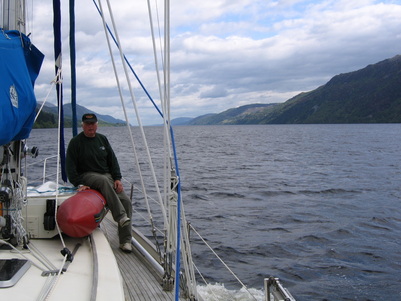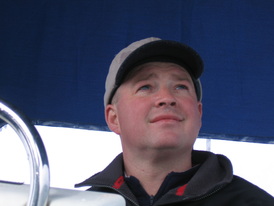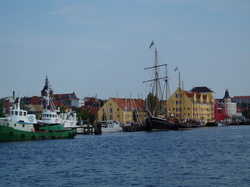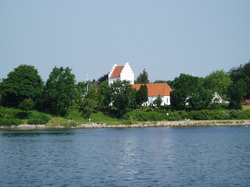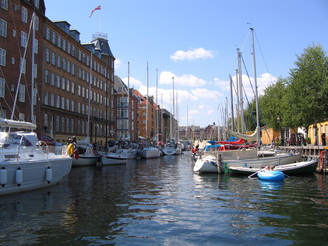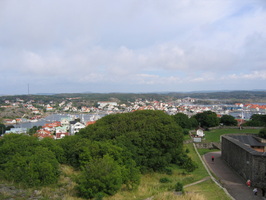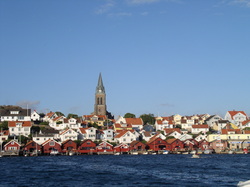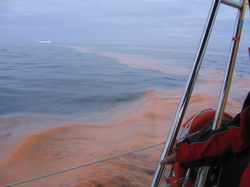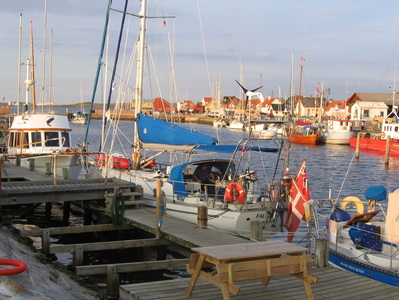2005 - Baltic Reprise
In the late 80s I worked for the Army running the Kiel Training Centre at Kiel in the Baltic. I thus know the southern Baltic quite well. This trip was to revisit some of the places I knew and to explore others.
The facts about our cruise to the Baltic in Faustina II in 2005 are simply stated. There were four main phases: the first was from Bangor to Kiel; the second, cruising in Denmark; the third, cruising in Sweden; the fourth, the return to Bangor from Göteborg. This log describes our voyage in general outline and highlights some of the things we saw and the things we learnt that might be of use to others passing that way.
The facts about our cruise to the Baltic in Faustina II in 2005 are simply stated. There were four main phases: the first was from Bangor to Kiel; the second, cruising in Denmark; the third, cruising in Sweden; the fourth, the return to Bangor from Göteborg. This log describes our voyage in general outline and highlights some of the things we saw and the things we learnt that might be of use to others passing that way.
Phase 1 – Northern Ireland to Kiel, 8 – 20 June
The crew from home to Inverness was Ann, and my friend Bruce from the Newtownards SC. We left Bangor on 8th June to go Kiel in Germany via the Caledonian Canal, down the east coast of Scotland and England to North Shields, across the North Sea to Helgoland and then through the Kiel Canal to Kiel where we arrived on 20th June.
It is easy to underestimate just how far it is from Bangor to Torr Head and of course it’s much further to Corpach where one enters the Caledonian Canal. Altogether it’s about 160 miles. It took two days for us to get to the canal with a night at anchor en route. We stopped there in the Sea Basin for a day, in glorious weather and in sight of Ben Nevis, to get the faulty engine stop solenoid diagnosed by the very helpful Corbach Boat Yard.
The Caledonian Canal. The Canal is 60 miles long and has 29 locks and 10 swing bridges that are operated by canal staff. It incorporates 3 lochs, Loch Lochy, Loch Oich and Loch Ness, the latter comprising more than a third of the total ‘canal’ length. It takes at least two days to transit - but it’s worth taking a little longer. Mooring places en route are free and the Seaport marina at Inverness offers one night free (per year).
It cost £184 take our 40 ft Bowman one way through the canal and I initially thought ‘how expensive’. However as we went through and I saw how well it was all kept and how helpful the staff were I changed my mind. It’s good value – and the return trip in the same year cost ‘only’ £129 as returnees get a discount.
We all thought that the least attractive part of the canal was Loch Ness. The canal sections are generally very scenic as are the areas around the locks as the keepers vie for top prize in the gardens competition! There are many places to stop for a meal ashore or to ‘overnight’. We had particularly good meals on each transit at the ‘Bothy Bite’ at Fort Augustus – a suitable overnight stopping place en route.
At Inverness it is easier to moor alongside the wall between the marina and the road bridge rather than in the marina, which has very few unreserved slots. A large Coop and other stores are close by, so victualling is easy. The city centre is a 20-minute walk away. Buses to and from the airport arrive there, which makes it a good place to change crews. That evening we walked about a mile along the canal to the village of Clachnaharry (near the sea locks) to eat very well at the recommended real ale pub, the ‘Clachnaharry Inn’. Ann left us next morning to fly home – she very sensibly had no intention of crossing the North Sea with us.
Bruce and I left the canal and headed for Peterhead, but soon decided to stop earlier for the night at Buckie instead. Buckie harbour has high walls but the HM met us and made us welcome and then drove us into the bleak looking town to look for a meal. It seemed to offer chips or chips. We had chips. It’s that sort of place. Next day we went on to Peterhead with its adequate marina (£16) from where the town is a good 30 minutes walk. We next called in at Eyemouth, which I have heard well spoken about. Take it as you find it! For us it was less than brilliant. We had a problem finding somewhere to moor and there was no reply from the HM. I had to land Bruce to move a RIB to make space. The town is ‘alright’ and close-by. There was no water easily available and no electricity. By chance I came across a deputy HM who wanted to charge us £21 for the privilege of an overnight stay. Only after complaining about the lack of facilities etc did the charge get reduced to £16 - still too much in my view.
Bruce and I left the canal and headed for Peterhead, but soon decided to stop earlier for the night at Buckie instead. Buckie harbour has high walls but the HM met us and made us welcome and then drove us into the bleak looking town to look for a meal. It seemed to offer chips or chips. We had chips. It’s that sort of place. Next day we went on to Peterhead with its adequate marina (£16) from where the town is a good 30 minutes walk. We next called in at Eyemouth, which I have heard well spoken about. Take it as you find it! For us it was less than brilliant. We had a problem finding somewhere to moor and there was no reply from the HM. I had to land Bruce to move a RIB to make space. The town is ‘alright’ and close-by. There was no water easily available and no electricity. By chance I came across a deputy HM who wanted to charge us £21 for the privilege of an overnight stay. Only after complaining about the lack of facilities etc did the charge get reduced to £16 - still too much in my view.
There is no great scenic interest on the voyage south as we passed Aberdeen in the gloom and entered English waters at Berwick-upon-Tweed. We sailed ‘inside’ the Farne Islands but the poor visibility meant that we were able to see very little. I had looked forward to a view of Lindisfarne but everything was dull and grey. We reached the Tyne that afternoon and, having cleared our entrance with the HM, made our way 2 miles up-river to the Royal Quays marina. We entered through a lock, which was efficiently done, and the staff directed us to a mooring over the radio. This is a fine marina with excellent facilities (£24 per night plus a power card). We needed some marine items and I ordered these from a firm in Newcastle and they were delivered as promised before we left. Nigel S, from the Newtownards SC, arrived to join us here and we had a superb meal in North Shields at the ‘Magnesium Bank’ pub, about 20 minutes walk away along the river.
We left for the North Sea crossing next day. The first 12 hours or so were a bit rough and no one felt too well. Then things improved and we had a good sail. Late in the afternoon of the third day we found Helgoland - it appeared out of the haze only two miles ahead of us - and went alongside the berthing place for visiting yachts in the outer harbour. Folks back home were telephoned to announce our safe arrival. (I have very mixed feelings about mobile phones. Without doubt they are the greatest boon when organising crew changes but always being in touch (when in sight of land at least) severely detracts from the ‘getting away from it all’ feeling that I enjoy so much about cruising. I should enjoy hearing members’ opinions about that on the ICC website!)
We spent about 24 hours on the island, now mainly famous for its duty-free status. Hordes of day-trippers arrive each morning and depart in the afternoon laden with booze and perfume. I stocked up the boat’s gin supplies and then walked around the island to look at the breeding colonies of sea birds on the cliffs at the northern end of the island. Since I had last walked around the island some 18 years ago the path has been covered in tarmac - otherwise it looked much the same.

The algaae bloom. We were to see much more later in the voyage.
In mid-afternoon (in order to catch the tide) we left and crossed to the southern side of the buoyed channel into the River Elbe. On the way we passed through great areas of what looked like red sand floating in the water, but we soon realised that we were seeing an algae bloom. In the gathering gloom the flood tide swept us quickly up to Cuxhaven marina where, despite the late hour, the HM was present to let us into the showers.
Next day we made our way up-river to the Brunsbuttel entrance of the Kiel Canal (more properly known as the ‘Nordostsee Kanal’.) Along with several other yachts we waited to be called to enter. As ever with our German friends one has to accept that no one will queue and everyone will try to get in first. So it happened here. We got in to the huge lock safely, together with a long barge and were soon locked through into the canal.
Next day we made our way up-river to the Brunsbuttel entrance of the Kiel Canal (more properly known as the ‘Nordostsee Kanal’.) Along with several other yachts we waited to be called to enter. As ever with our German friends one has to accept that no one will queue and everyone will try to get in first. So it happened here. We got in to the huge lock safely, together with a long barge and were soon locked through into the canal.
The Kiel Canal. The canal is 60 miles long with a lock at each end. The locks must not be entered until you are called in. Fines can be imposed! The canal passes through flat terrain from Brunsbuttel to Kiel. Yachts must motor throughout though sails may be used to supplement the engine. Movement after dark by pleasure craft is not permitted. Passage can be made in a single day. The transit cost us only €18.
The canal is not very exciting but it’s quite attractive. There are no ‘long’ views, only what is on the banks. At Rendsburg, about 2/3rds along the length, one passes under a transporter bridge over which I had taken my car many years earlier. It seems to be out of commission now.
There are only a few places en route to stop. We pulled into probably the prettiest and quietest of them, the lake called Flemhuder Meer. Not much of this is deep enough for a yacht but there is sufficient space for about 10 boats. The next day we went the remaining 10kms to the locks at Kiel where we paid and were let through into Kiel Bay and the Baltic.
There are only a few places en route to stop. We pulled into probably the prettiest and quietest of them, the lake called Flemhuder Meer. Not much of this is deep enough for a yacht but there is sufficient space for about 10 boats. The next day we went the remaining 10kms to the locks at Kiel where we paid and were let through into Kiel Bay and the Baltic.
30 minutes later we were moored at the British Kiel YC where in the late 1980s I had worked for 3½ years. ‘Going back’ can often be disappointing but this visit was a delight. It was great to see the same enthusiasm for the job that I remember so well. The club, although a military establishment, welcomes visitors and does all that it can within the restraints of its work to provide assistance. The showers are excellent – and ladies, they have a bath for you! Another bonus was that our visit had been carefully timed to coincide with Kiel Week (always the last full week in June). This must be one of the world’s biggest regattas. The racing takes place out at sea away from most spectators but there is much else to see and do. One day we counted at least 25 Tall Ships, those with three or more masts, and many more two-masted Baltic Traders and similar. These go out from the harbour each day and make a spectacular sight. Ashore there is a fair called the Kiellinie that’s stretches along the sea front for well over a mile where one can eat food from cuisines from all over the world and watch concerts and go on fair rides. It’s huge, great fun – and it stops each evening at midnight - dead!
Ann rejoined the boat here and Bruce and Nigel left by train to go to Berlin whence they had booked a cheap flight home.
Phase 2 - Denmark, 23 June - 15 July
After four days, on 23rd June, Ann and I went north, spending the first night in Schleimunde, the estuary that features in ‘The Riddle of the Sands’ shortly after Carruthers joined Davies on ‘Dulcibella’. It’s flat all around and featureless and is home to great flocks of swans. The anchorage opposite Maasholm that we shared with a few others was big and protected.
Then we were into Denmark and we went first to Marstal on the island of Ærø. This is quite a small and elongated harbour. In the attractive town there is a wonderful maritime museum that has pictures and artefacts that describe the ships that were built here and which sailed from here to fish on the Grand Banks and elsewhere far away. Photos showed the harbour jammed with these boats.
After four days, on 23rd June, Ann and I went north, spending the first night in Schleimunde, the estuary that features in ‘The Riddle of the Sands’ shortly after Carruthers joined Davies on ‘Dulcibella’. It’s flat all around and featureless and is home to great flocks of swans. The anchorage opposite Maasholm that we shared with a few others was big and protected.
Then we were into Denmark and we went first to Marstal on the island of Ærø. This is quite a small and elongated harbour. In the attractive town there is a wonderful maritime museum that has pictures and artefacts that describe the ships that were built here and which sailed from here to fish on the Grand Banks and elsewhere far away. Photos showed the harbour jammed with these boats.
About Danish marinas.
Firstly there is, in my view, no point at all in buying a pilot book for Denmark. At every harbour the HM will supply you with three free books called ‘Sejlerens Havnelods’. These provide a good chartlet and an aerial photograph of all Danish marinas and harbours. The text is in Danish and German but it is quite easy to work out the essentials.
Secondly, very few marinas have anyone on duty during the day so don’t use your mobile to ring ahead to make enquiries. Just get in, find a place and wait until the evening when a HM may appear. Some marinas have automatic pay stations for the mooring and for electricity. The machines (and the HMs) issue plastic or sticky paper tags that have to be attached to the boat for checking.
Thirdly, the universal method off mooring in Danish marinas is to go bow first between two piles. The bow is attached to the shore and a line is taken from each quarter to one of the piles. The essential is to drop a loop over each pile while passing it on the way in. It is well worth watching the locals do this to see how elegantly and easily it can be done. (If I were to offer advice it would be to not deploy any fenders until you are through the piles and to take a line from each quarter forward to the widest part of the boat from where it can most easily be deployed over its pile - and concentrate on the windward pile.) However many, even most, of the piles will not permit a boat wider than about 2.70m to get through. One has to learn to judge the width! Happily some harbours have an alongside wall where larger boats can moor, though this may involve having another large yacht or motorboat alongside.
If Marstal was interesting (and it was) then our next stop Ærøskøbing, reached via 5 or 6 miles of shallow but well marked channels, was a delight. There is a new marina there but if your boat is over 35ft then go on into the nearby harbour where there is ample wall space. The town is a blast from the past and the inhabitants have self-imposed a ban on any incompatible development. The houses are small, half-timbered, multi-coloured and most have a bicycle or tall hollyhocks (or both) against the wall. The church here, as in Marstal, has model ships hanging from it’s ceiling in memory of seamen lost at sea. Here too is a museum of ships in bottles, hundreds of them all made by a local enthusiast, each well worth seeing. Walking round the town is something everyone should do, and we did.
Over the next five days we nearly circumnavigated the large island of Fyn clockwise, bypassing Sonderborg, sailing along the Als channel to the long shallow inlet at Dyvig where we anchored for the night. A severe gale warning next day caused us to take cover at Aarosund where we assembled our folding bikes and went for a long ride inland. We bought some delicious strawberries from a farm shop just up the road.
It was after lunch on the following day before the wind moderated. We made our way past Middelfart and Frederica to Bogense where despite a very strong cross wind we made a very polished arrival between the piles. We doubled all the windward ropes and hung in there until the morning as the wind rocked us violently.
Next day I was very pleased with myself as I thought that I had found a place on the chart that looked perfect for a nice solitary anchorage. This was at Korshavn, an inlet just south of Fyns Hoved, the most northerly point of Fyn. Needless to say it was a popular spot but it was pretty and we went ashore and walked for many miles. We stayed there at anchor all the next day and then rounded Fyn Hoved and went south to Nyborg. We had to go under the Great Belt (Storebælt) Bridge. The span it is preferred that yachts use is 18m high. I double-checked the height of our mast and it came to 16.5m. Ann went below as we got near the bridge, convinced that we were about to lose the mast. It looked close, and it was!
David and Valerie, old friends of mine, joined us in Nyborg. With them we went to Svendborg with its barn-like castle and re-visited Ærøskøbing for a wander. Then we motored along the channel towards Marstal but, some way along it, took a more northerly route, to Rudkøbing. We moored in the harbour rather than the marina (in error!) but it was certainly a more interesting place to be. We ate out here as we did several times and found the prices not a lot different to those in UK – and the standards were generally high.
On passage next day we had trouble with the engine starting system and diverted to Nyborg to get it fixed. The next night we anchored off the marina at Karrebæksminde (don’t worry, there is no test on these names!) before we made our way up the east coast of Jutland and The Sound (Ǿresund) towards Copenhagen. We rang ahead to the marina in the centre of the city. The HM happened to be there and told us that he had no spaces free but he could take us after 1400 the next day, 8th July. While talking to him he told us about the underground bombs in London and that set us all ringing home to check on people we knew might be in London. I decided to go to Flakfort which is an island made to defend Copenhagen against the British in the early 19C. It was basically a big earth gun turret with a moat all around it built about 4kms from the city. Now it is a perfect base for yachts and provides a picnic retreat for the city yotties at the weekends. The people that we met there were amazed to know how we Brits had even heard of the place. Of course it’s in the pilot books. The weather was perfect and we had a very pleasant scramble around the fortifications and had showers ashore.
Next afternoon we crossed the shipping channel to Copenhagen and took a mooring in the crowded but very conveniently sited Wilders Plads marina. This was very similar to parking in a street but with water instead of tarmac! It is well placed for visits to the rest of the beautiful city. We used our folding bikes (in a city that caters very well for cyclists) to see the Little Mermaid and other sites, we went by tourist boat around the canals (and later enlarged on that in our own RIB), and of course we had an amusing but quite expensive evening in the Tivoli Gardens. We just loved Copenhagen! In the busy season particularly it would be wise to contact the HM well ahead and book a place in the marina.
Our friends left us here and Ann and I had another night at Flakfort before heading north to Helsingor with its ‘Macbeth’ Kronborg Castle. That is only a 15-minute walk from the marina. Its Shakespearian relationship is its main interest but it’s worth a walk around. The town is pleasant too.
The weather had turned vile and we had electrical storms and lashings of wind and rain. It was therefore no hardship to stay there for two days while an electrical problem was fixed competently by a mechanic who was fluent in English. There is also an excellent chandlery shop at the marina and we were able to acquire another gas tank. This is a long story but suffice to say that seemingly every country in Europe has a different gas tanking fitting system. There is little or no commonality which makes it inconvenient and expensive!
Phase 3 – Sweden, 16 July – 10 August
On Sat 16 July we headed north for Sweden with a heavily reefed sail plan. We made slow progress against big seas and strong winds and quite soon I decided to divert to the small harbour at Mölle on the Kullaberg peninsular on the west coast of Sweden. The wind was from the NW and the harbour entrance faced NW – and I had a long look before attempting the entry. We made it safely and then found that the harbour was full. We tied the bow to a pile, head to wind, and hung there to think about it! I tried to go alongside two other yachts but that was hopeless, as they were really much too small to take us. The HM came to the rescue by suggesting that we jammed between two piles, pointing at the wind, where there was only a RIB moored. We did that and kept the boat steady with the stern anchor and a line ashore. That worked well and we were able to get ashore over the cruiser in the next ‘bay’.
Mölle is well worth a visit for the walking. The Kullaberg peninsular is a superb nature reserve park. The walk to the lighthouse at the end is about 3 kms and is beautiful. There is a road but also a path beside it, which goes through the woods. The town itself was quite lively. When we arrived there was a fête with the usual stalls - but the soap cart racing for boys of all ages was more fun! We spent a very pleasant full day there walking and waiting for the wind to subside.
We had taken advice on possible stopping places further north and so when we left we headed for an anchorage behind the island of Malö. Ideally this would involve tying to a rock with a stern anchor deployed but we were new to that system and for now I preferred to anchor.
We had taken advice on possible stopping places further north and so when we left we headed for an anchorage behind the island of Malö. Ideally this would involve tying to a rock with a stern anchor deployed but we were new to that system and for now I preferred to anchor.
Cruising in Sweden.
Two publications are necessary for happy cruising in Sweden. The first are the chart folders called Båtsportkort. These are really excellent and essential if one is cruise the rock-strewn coasts of Sweden with any degree of confidence. The second is a book of rock mooring places in Bohuslän , the west coast of Sweden, (Tre Veckor i Bohuslän) produced by the Swedish Cruising Association. This contains chartlets and aerial photographs of the sites that the Club have set up with mooring spikes. The book is rather clumsily indexed but the contents, once understood, are useful. The problem however is that these sites can become very crowded.
The normal way of mooring in Sweden is to lay a stern anchor and then take the bow up to a rock, leap ashore and tie-up to a hook pushed into a crevice or to a spike already there. We used some of the sites from the book but by looking carefully at the charts it is often possible to find one’s own rock mooring places as many of the rocks go straight down into the water with adequate depth to bring the boat’s bow near enough to jump ashore with a hook and rope. The special hooks with rings can be bought at any chandler in Sweden.
Plenty of people anchor too but rock moorings or marinas are more favoured.
The tradition of Allemansrätt (Everyman’s Right) means that one can land and walk anywhere in Sweden (and I think Norway too) subject to sensible provisos such as not interfering with people’s privacy, respecting crops and animals, etc. There are hundreds of islands to explore on this coast – most are rocky though some are covered in woods and fields.
Two publications are necessary for happy cruising in Sweden. The first are the chart folders called Båtsportkort. These are really excellent and essential if one is cruise the rock-strewn coasts of Sweden with any degree of confidence. The second is a book of rock mooring places in Bohuslän , the west coast of Sweden, (Tre Veckor i Bohuslän) produced by the Swedish Cruising Association. This contains chartlets and aerial photographs of the sites that the Club have set up with mooring spikes. The book is rather clumsily indexed but the contents, once understood, are useful. The problem however is that these sites can become very crowded.
The normal way of mooring in Sweden is to lay a stern anchor and then take the bow up to a rock, leap ashore and tie-up to a hook pushed into a crevice or to a spike already there. We used some of the sites from the book but by looking carefully at the charts it is often possible to find one’s own rock mooring places as many of the rocks go straight down into the water with adequate depth to bring the boat’s bow near enough to jump ashore with a hook and rope. The special hooks with rings can be bought at any chandler in Sweden.
Plenty of people anchor too but rock moorings or marinas are more favoured.
The tradition of Allemansrätt (Everyman’s Right) means that one can land and walk anywhere in Sweden (and I think Norway too) subject to sensible provisos such as not interfering with people’s privacy, respecting crops and animals, etc. There are hundreds of islands to explore on this coast – most are rocky though some are covered in woods and fields.
We watched carefully as other boats come up to the rocks to moor to see how it was done. I would recommend anyone to do the same before trying it. The local sailors do it with a nonchalance that makes one feel very amateurish! It’s not the easiest thing for two somewhat elderly people to do, but before long we were making a reasonable job of most landings.
After a blustery night we headed north towards Göteborg (or Gothenburg). We had hoped to get into the marina of the Royal Göteborg YC at the mouth of the River Göta some 5 miles or so from the city centre. It had been highly recommended but it was totally full and so we motored up river to the Lilla Bommen marina, which is as near the city centre as it is possible to get.
Swedish marinas.
They are nearly all private and they may or may not have room to take you. Every slot is personally owned. There are however many ‘Gasthamns’ marked as such on the charts and clearly signposted in situ. It is rarely difficult to find somewhere to moor overnight or for shopping and most marinas seem to have power and water available. Most of them have alongside mooring for bigger boats (i.e. over 35ft LOA).
Lilla Bommen is a Gasthamn and somehow its superb ex-naval officer HM will always make room for another boat. It lies under the prominently ugly ‘Lipstick’ building designed, we were told, by a Scotsman. This marina is a very handy crew-changing place – and it has a good laundrette. Buses from the City airport (where the cheap flights land) arrive barely ½ mile and a pedestrian bridge from the boat. The huge ‘Nordstan’ shopping centre is just over the said bridge and buses and trams leave from nearby to take one to, amongst other places, the Liseberg Park (a better form of Tivoli Garden). I don’t think anyone would call Göteborg a beautiful city but it’s worth a few walks.
Over the next few weeks we did three crew changes from Göteborg. The first change involved Chris B (ICC) with his 5-year old daughter 'A' together with his niece 'I' to keep 'A' company. With them we went north into the wonderful Bohuslän archipelago visiting the island of Marstrand with its huge fort that looks out over miles in every direction. Marstrand is the Cowes (some say Burnham!) of Sweden where people go to holiday, to sail and to swim. Good fresh fish, fruit and bread can be bought on the island and the mainland, a 3-minute ferry ride away, has a good conveniently placed supermarket.
Going on northwards we moored in marinas and against rocks and in a week we got as far north as Ellös where the Hallberg Rassy yachts are made. Chris wanted to see where they made the boat that his father Peter B (ICC) bought to sail around the world in 1992/93! We circled inside their marina (to show them a quality boat!) but they were all on holiday.
We had a great week with a lot of rock scrambling, walking, ice creams and meals ashore.
We had a great week with a lot of rock scrambling, walking, ice creams and meals ashore.
Our next crew change brought Hazel B (ICC) and Patricia C for two weeks. We covered much the same ground north of Göteborg. Going north we followed what might almost be called a road through the rocky islands. There are only a few routes through inside the islands and these are well buoyed and marked. You pass through channels with attractive villages spread along each side, squeeze through narrow gaps between rocks that you can and often have to go so close to that you can touch them as you pass.
In July the traffic density had been extremely high with yachts under full sail and high-speed motor cruisers giving no quarter as they manoeuvred through the passages. In August the main holiday period is over and there are already fewer boats around. Nevertheless, en route north, we couldn't stop at Marstrand as their big regatta was in progress and the marina was congested. But it was easier to find a good uncrowded rock mooring elsewhere. We got as far north as Fjällbacka, which is probably best known in Sweden for being the birthplace of Ingrid Bergman. The town, about 30 miles south of Norway, has a huge marina and is backed by a huge 74m-high rock that has steps up it leading to wonderful panoramic views.
On the way south again we diverted to take the long arm into the east that leads towards Uddevalla, around the large island of Orust. I thought that this route might be a mistake as it is quite a long diversion and if it were to be dull then we would have wasted at least two days. It turned out to be a delight. The shores of the mainland and the islands are covered with trees and the scenery was generally more pastoral than the offshore islands. Lovely houses dotted the shore and the sailing scene was all less frantic than outside. We found a couple of attractive and safe anchorages. We rarely sailed very far in a day preferring rather to relax and perhaps take a walk or, occasionally, eat ashore. The weather, which earlier in our holiday had been fine and sunny, had over these last few weeks turned duller. It rarely rained but we didn’t get too much Baltic sunshine either. No deep sun tans!
Phase 4. Göteborg to Bangor, 10 – 23 August
Back at Göteborg again on 10th August, the ladies left and David and his son Tim, and Stuart, all members of the Newtownards SC replaced them. They had all asked to help me with the return passage in order to get some passage-making experience. I allowed them only a few hours to look at the city and then we headed north to Marstrand, where we stopped while they walked around and looked at the fort, and then on north to a rock mooring. I felt that they should get some idea of the nature of the archipelago before we left Sweden.
We sailed over to Skagen in Denmark next day. I went as close to the northern tip of Denmark as I dared. The Skagerrak and the Kattegat meet here and it is shallow a good way offshore. We could see people wading out for several hundred metres – trying to reach Norway?!
Skagen harbour contained many Swedish boats loading fuel and duty free goods. Stuart and I visited the highly recommended museum with wonderful paintings from the late 19th century artists’ community that formed here to make the most of the Skagen’s renowned special light. That evening we challenged a fish restaurateur to do his best for DKr100 and he gave us a feast fit for a king – to the obvious envy of the other customers!
Next day we went south and entered the Limfiord, the natural cutting that divides the northern tip of Denmark from the rest of the country. There was a fresh wind and I had to make several attempts at mooring alongside a German yacht in Hals. The crew had a long evening at a splendid local pub but all were present and correct when we set off along the fiord next morning.
Limfiord. The fiord is about 75 miles long from Hals to Thyborøn. There are six bridges to pass and five of them have to be opened to allow yachts to pass through. There is 26m clearance on the other. The time of the next opening is displayed on each bridge. Boats have to fly an ‘N’ flag at half-mast to show that they want the bridges to open. The 24-chart folio ‘Dänemark 4’ produced in Germany by Delius Klasing, which covers the north of Denmark and its western coast, and Limfiord is recommended. Included is a booklet with the plans of all the harbours, waypoints and more.
Waiting for the bridges to open can severely prolong the transit time but we were reasonably lucky. We reached Aalborg after a couple of hours and passed fairly speedily through the opening road and rail bridges. We needed bread but as it was Sunday we thought that might be difficult. Nevertheless we moored in a marina and Tim and I went off and found what we needed about a mile away. We left again at 1430 and after passing another opening bridge at Aggersund we stopped at 1800hrs for the night at the delightful marina at Løgstør. The marina is built in the entrance to an old canal and we were lucky to find an alongside slot into which we fitted with inches to spare. The town was an interesting place with an obvious pride in itself.
The scenery in the Limfiord varies from dull to a bit less dull especially when the sun doesn’t shine. The channel is often narrow and well buoyed but the water, albeit usually quite shallow, often spreads out for a mile or more on either side. The land is flat and so the views are short. There are lots and lots of wind generators.
We reached Thyborøn at the western end of the fiord having managed to sail for only about 2 hours as the wind had been, as ever, on the nose. We had to rush to reach one bridge and made it, mainly as there were only two boats wanting to go through and they waited 5 minutes for us to arrive. The channel leading to Thyborøn is long and very narrow but we arrived safely and took a berth at the very northern end of the harbour. This is a snug berth with few facilities though there is a supermarket quite nearby.
We listened carefully for the weather forecast, which offered W4 becoming SW4 or 5. Our required course to Peterhead was 280º and so we really didn’t want anything with ‘W’ in it! Next morning David managed to find a Shell man to sell us diesel from a barge in the fish harbour and then, with the boat prepared, we were off across the dreaded North Sea again. At first we bore off to the south and later tacked back northwards - and by 1800 we had made good a mere 44 miles. We heaved-to to cook and eat our evening meal. That night was wonderfully clear and for an hour or two we had a gibbous moon brightening the dark.
Next day dawned grey with a fluky wind. We motored for a few hours and then we ran into thick fog for an hour or so. The wind went to SSW 4/5 and suddenly we were flying and even required a reef in the Main. The waves were big but on the beam and easy. That evening from my bunk I heard David and Stuart discuss which of the oilrigs ahead to leave to port and which to starboard. They sounded confident and so I went back to sleep. It was great sailing and it wasn’t a hard decision to bypass Peterhead and go directly on to Inverness. At midnight of the second day at sea Fraserburgh was abeam but the wind died on us and we had to motor along the Moray Firth. It was a cold day. We were off Buckie at 0630 and Lossiemouth at 0830.
At lunchtime we anchored off Fort George in order to enjoy our food before making our way with the tide past Inverness harbour entrance to the Caledonian Canal entrance at Clachnaharry. The Seaport marina had padlocked all its power outlets since we had last visited and now produced a full A4 sheet of instructions about how they should be used before they would unlock ours. The world is going MAD!
Sheilah B (RNIYC) joined us next day and Tim had to leave us. We took 3 days to pass back along the canal. In each loch the wind was against us but David quite properly insisted that we should sail. Tacking in the narrow Loch Ness in a brisk breeze is hard work! Somehow it was always me who did the winch work! Hmm. Fortunately the wind died enough to warrant a stop near Urquhart Castle. However the canal transit was fun and generally relaxing. We spent the first night on the pontoons below Fort Augustus. Next day we went through to Loch Oich and stopped to look at the fountain of the Seven Heads (the scene of a gruesome happening several centuries back). We ate Sheilah’s kind offering of smoked salmon and then watched as about 16 ladies and gentlemen of a certain age who had paddled about 8 canoes, all lashed together, upwind to this point, headed out into the loch and raise their umbrellas to go away downwind under ‘sail’! Wonderful. That night we anchored at the west end of Loch Lochy. It was a still evening and we had a stunning view across to Ben Nevis. A combination of drinks, an excellent curry concocted by the jovial efforts of David and Sheilah, and music by the Buena Vista Social Club made it a memorable evening.
The photos below are impressions of our transit of the Caledonian Canal. Click on the first one and then click on NEXT to see them all full size.
The photos below are impressions of our transit of the Caledonian Canal. Click on the first one and then click on NEXT to see them all full size.
Next day the forecast was for Southerly Force 10 winds! We hotfooted off towards Corpach but we had to wait for over an hour to enter Neptune’s Staircase, the flight of 8 locks near the west end of the canal. The only people in sight were very damp and windswept Japanese and German tourists who had paid to get there! Clearly there was no sense in leaving the canal with that wind expected and so we moored on the Reach one lock away from the Sea Lock at Corpach. We made the most of our enforced stay by eating out at a very decent pub nearby.
The wind strength peaked to hooligan level at about 0300 and all next morning it remained strong from the SW – exactly the wrong direction for us to go down Loch Linnhe. We kept hoping and expecting the wind to veer to the west as the deep low went north, but it didn’t. As LW prevented the Sea Lock from being opened after 1400 we had to decide by then whether to leave. At 1345 we decided to go. We motored hard against the wind and happily the tide was still with us as we passed the Corran Narrows. We went by Port Appin at 1730 and reached Dunstaffnage gratefully at about 1900.
We were away again next morning at dawn (0540) and with the wind still SWly, albeit quite light and always promising to go to NW, but not doing so, we motored nearly all day and reached Bangor at 2230 on Thursday 25 August.
The cruise had lasted 2 months and three weeks. I had been on board throughout but had been joined at various times by 13 others. It had all gone reasonably to plan and if the weather was latterly not as good as it might have been, at least it hadn’t been too bad. For me the voyage had been a return to the Baltic cruising grounds that I had sailed around 15 or more years ago, and returning to see them again was a delight. I hadn’t been on the Caledonian Canal before. I had enjoyed it all.
The cruise had lasted 2 months and three weeks. I had been on board throughout but had been joined at various times by 13 others. It had all gone reasonably to plan and if the weather was latterly not as good as it might have been, at least it hadn’t been too bad. For me the voyage had been a return to the Baltic cruising grounds that I had sailed around 15 or more years ago, and returning to see them again was a delight. I hadn’t been on the Caledonian Canal before. I had enjoyed it all.







